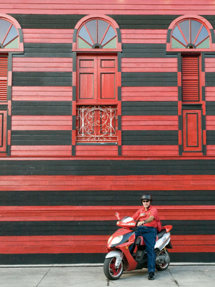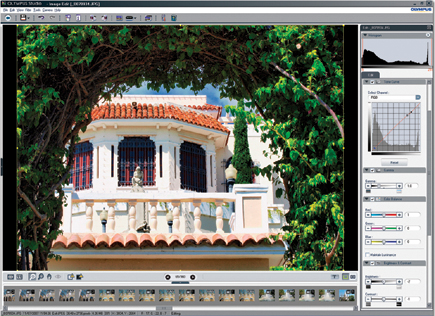The Olympus E-3; A Pro-Caliber 10Mp D-SLR Page 3
The white balance presets often produced very good results except under artificial
lighting. Activating the new external white balance sensor provided greater
accuracy in such conditions, but the Custom and Kelvin white balance features
were still required for perfect results. The "gradation control"
options should be useful for providing greater highlight and shadow detail under
contrasty conditions, but they did not provide a significant improvement. Even
so, I would recommend leaving the camera set to the Auto Gradation mode, for
a slightly wider dynamic range.
Low ISO image quality is superlative. My best ISO 100 to 400 JPEGs are clean,
silky smooth, and finely detailed. Resolution is outstanding, color saturation,
contrast, and sharpness are quite high for a very pleasing overall effect. In
all of these aspects the E-3 is even better than the EVOLT E-510. I was able
to make gallery-quality 13x17" inkjet prints at 240dpi after slight optimization
and re-sizing in Photoshop CS3. The ISO 100 and 200 images would stand up to
much greater enlargement.
 |
|
|
At ISO 800 digital noise is certainly apparent but it's not objectionable; resolution of intricate detail is well maintained. By ISO 1600 and especially at ISO 3200, the noise pattern is obvious but the specks are not colorful so the effect resembles film grain. Because the noise pattern obliterates intricate detail at ISO 3200, that level is really for use when there's no other way to get a steady photo in dark conditions. Setting a higher level for the Noise Filter does produce smoother images but smudges fine details causing a loss of resolution.
 |
|
|
The JPEG algorithms are really excellent so there's really no need to
shoot in the Raw mode in terms of image quality; the difference is barely noticeable
even in 11x15" prints. Of course, a raw capture does provide other benefits:
greater color depth (if desired) and the ability to make major technical modifications
with a nondestructive process in the raw converter software. The Olympus Master
2 program is family-oriented, providing only basic raw adjustment tools. It's
worth paying extra for the multipurpose Olympus Studio 2 program which provides
many pro-caliber utilities; it also allows for remote control of the E-3 from
a tethered computer.
The Bottom Line
Higher resolution or a faster framing rate might attract a wider range of professionals,
at least those who do not already own a full system of another brand. On the
other hand, not everyone needs to shoot more than 25 frames in 5 seconds and
the 10-megapixel resolution is adequate for many purposes. Because of its great
reliability, comprehensive feature set, and great image quality, the Olympus
model should certainly appeal to the most advanced photo enthusiast. More importantly
perhaps, the price is right! In fact, in the professional category, this one
deserves my "Best Value" award. It's not only the most affordable
but offers excellent return on the investment, making Olympus competitive in
the high-end category.
 |
|
|
 |
|
|
Technical Specifications
Sensor: 17.3x13mm Live MOS; 10.1 megapixels (3648x2736) effective;
4:3 aspect ratio
Lens Mount: Four Thirds; 2x focal length magnification factor
Shutter: Electronic; speeds from 60 seconds to 1/8000 sec selectable;
also, Bulb
Capture Formats: Numerous JPEG options, raw (12-bit), raw +
JPEG
ISO Equivalent: ISO 100 to ISO 3200 and Auto
Exposure Control: Center-weighted, 49-zone Digital ESP, spot
(1 percent), highlight and shadow based spot metering; exposure compensation,
bracketing, and AE Lock
Operating Modes: Aperture and Shutter Priority AE, metered
Manual, Underwater Program, shiftable Program
Image Stabilizer: In camera mechanical sensor shift system,
with two modes; compatible with all Four Thirds lenses
Color Space: Adobe RGB or sRGB
Storage: CompactFlash or Microdrive and xD-Picture Card slots;
UDMA card compliant
Connectivity: USB 2.0 Hi-Speed and video output
Power: Rechargeable BLM-1 lithium ion battery; optional AC
adapter and vertical battery grip
Dimensions/Weight: 5.6x4.6x2.9"; 1.79 lbs
Average Street Price: $1699, body only
For additional information on the E-System cameras, lenses, flash units, and
other accessories, visit the Olympus website at: www.olympus-esystem.com.
You may also contact Olympus at 3500 Corporate Parkway, Center Valley, PA 18034;
(888) 553-4448.
A long-time "Shutterbug" contributor, stock photographer Peter K.
Burian (www.peterkburian.com)
is the author of "Mastering Digital Photography and Imaging" (Sybex)
and several "Magic Lantern Guides" to SLR cameras. He is also the
co-author (with Tim Grey) of "Photoshop Elements 5 Workflow" (Sybex)
and teaches two online digital photography courses at BetterPhoto.com.
- Log in or register to post comments

































